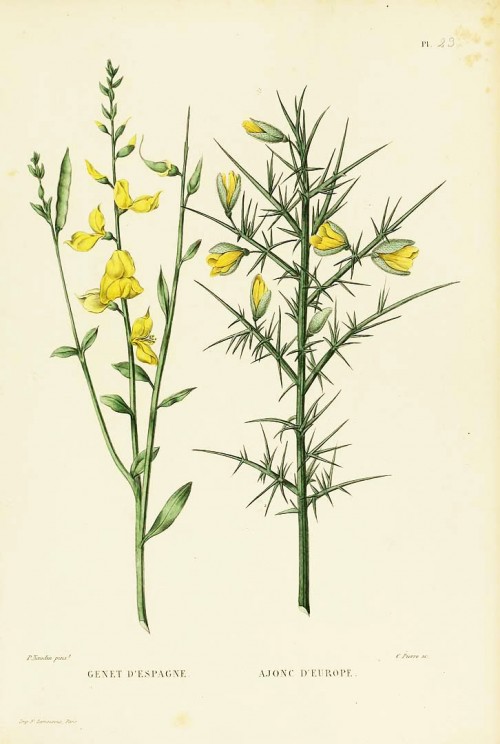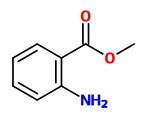Dies ist eine alte Version des Dokuments!
Spartium junceum L. - Fabaceae - spanish broom, Pfriemenginster, Spanischer Ginster
„S.junceum… the sole species in the genus Spartium… is a vigorous, deciduous shrub growing to 2-4m tall, … native to the Mediterranean in southern Europe, southwest Asia and northwest Africa… has been widely introduced into other areas, and is regarded as a noxious invasive species in places with a Mediterranean climate such as California and Oregon, Hawaii, central Chile, southeastern Australia, the Western Cape in South Africa and the Canary Islands and Azores…
The plant is also used as a flavoring, and for its essential oil, known as genet absolute.“
http://en.wikipedia.org/wiki/Spartium
„The flowers are bright yellow and very fragrant. They are 2 to 2.5cm tall and stand on 5 mm long pedicles in long, loose racemes terminal on young shoots… The shrub sheds its leaves in early summer, to prevent the evaporation of water through the leaves. Photosynthesis happens then only in the green rods. The species is highly poisonous. Poisoning cause vomiting, respiratory paralysis and kidney damage.“
http://de.wikipedia.org/wiki/Spartium_junceum
Broom flowers were picked early in the morning before sun becomes intense and vacuum headspace was collected 30 minutes after picking for 30-45 minutes. The concentrate of the headspace volatiles contained methyl anthranilate (32%), 2-aminobenzaldehyde (11%), benzyl cyanide (5.2%), indole (5%), phenylethanol (2.6%), phenylacetaldoxime (2%), α-farnesene (1.8%), and phenylethyl butanoate (1.1%).
[Joulain, D. „Study of the fragrance given off by certain springtime flowers.“ Progress in essential oil research (1986): 57-67]
„Of several species of Spartium (fam. Leguminosae), known as broom, Spartiium junceum L. is used in perfumey. It grows wild in the Mediterranean countries. According to Guenther, the yellow-golden flowers possess an odor 'reminiscent of orange blossoms and grape.' Another source describes the genet flower odor as 'dusty sweet, somewhat leathery and neroli-like.' … About 1,200 kg of flowers are required to yield 1kg of concrete which gives 0.30 to 0.35 kg of alcohol-soluble absolute. The absolute is viscous oil of a dark-brown color. Yields of the concrete ranging from 0.09 to 1.18 percent were reported by another source. The dark-brown solid waxy concrete gave 30 to 40 percent of absolute. A steam distilled concrete yielded 2 percent of a volatile oil which is only used in analysis and research.“
[Pajaujis Anonis, D. „Broom (genêt) in perfumery.“ Perfumer & flavorist 16.5 (1991): 55-57]
https://media.allured.com/documents/9139.pdf
The rich aromatic-floral scent of broom in bloom is composed of methyl anthranilate, indole, (Z)-hex-3-en-1-yl benzoate, nerolidol, eugenol, phenylethyl butanoate, phenylethanol, methyl benzoate, phenylacetaldehyde, linalool and many minor and trace constituents.
[Kaiser, Roman. „Environmental scents at the Ligurian coast.“ Perfum. Flavor 22 (1997): 7-18]
The flower scent of broom has been found a delicate combination of mainly (Z)-hex-3-en-1-yl butanoate (25.3%) and butyl butanoate (12.4%), phenylacetonitrile (3.0%), (Z)-3-hexen-1-ol (3.0%), (Z)-3-hexen-1-yl acetate (3.5%), (Z)-3-hexen-1-yl 2-methylbutanoate (2.7%), (Z)-3-hexen-1-yl isovalerate (1.0%), 2-phenethyl butanoate (2%), methyl anthranilate (5%), benzaldehyde (2.1%), 2-aminobenzaldehyde (1%), and vanillin (0.1%) eg.
[Meaningful scents around the World, Roman Kaiser, 2006, 145 and 266]
„The essential oil, isolated by hydrodistillation from fresh flowers of Spartium junceum L., was investigated by GC and GC/MS. The 24 main constituents of the samples were identified; the main components of the oil were kairomonal compounds, tricosane (22.9%), tetracosane (8.9%) and pentacosane (16.1%), constituting altogether almost 48% of total composition. These hydrocarbons constitute an important aspect governing the sensitivity of the insects in plant host selection.“
[Identification of volatile constituents from the flower oil of Spartium junceum. Miraldi, Elisabetta, Sara Ferri, and Gianluca Giorgi. Journal of Essential Oil Research 16.6 (2004), 568-570.]
„The extraction of quinolizidine alkaloids from fresh flowers of Spartium junceum is performed in ethanolic basic conditions… The extract is essentially formed by N-formylcytisine, N-methylcytisine, cytisine and anagyrine. The method allows a high recovery of N-formylcytisine which becomes the predominant alkaloid in S. Junceum flowers.“
[Extraction of quinolizidine alkaloids in non aqueous basic conditions: the case of Spartium junceum flowers., Belsito, E. L., Chidichimo, G., Di Gioia, M. L., Leggio, A., Liguori, A., Perri, F., Siciliano, C., Chromatographia, Vol.68(5-6), 2008, 345-349]

spanish broom (left)
Gourdon, J., Naudin, P., Nouvelle iconographie fourragère, Atlas, p. 62, t. 23, fig. 1 (1865-1871)
http://www.plantillustrations.org/species.php?id_species=963340



